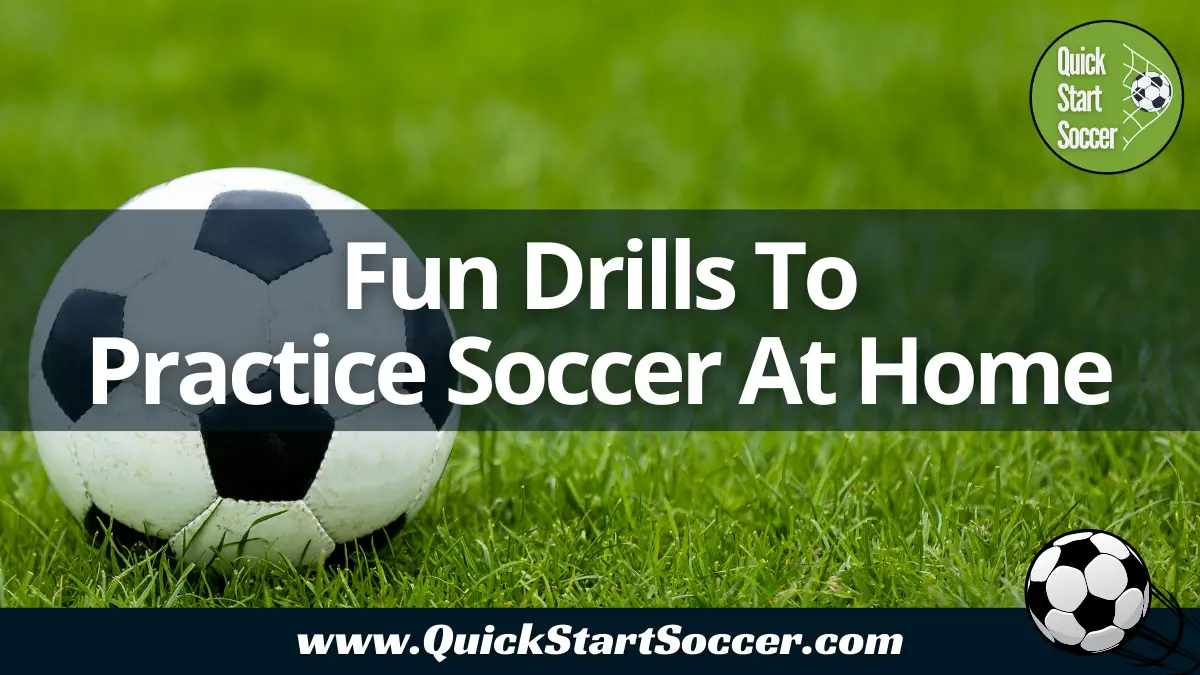7 Fun Activites And Drills To Practice Soccer At Home
Like any skill, to improve at soccer it’s important to practice, practice, practice! That means not only must you regularly attend soccer training sessions, but you must also practice at home and in your spare time. Below you’ll find 7 great soccer drills you can do at home by yourself. This can be in the backyard, or even inside if you have enough space. These soccer exercises will improve your ball control, speed, agility, and much more.
Soccer Drills To Practice Soccer At Home
Juggling
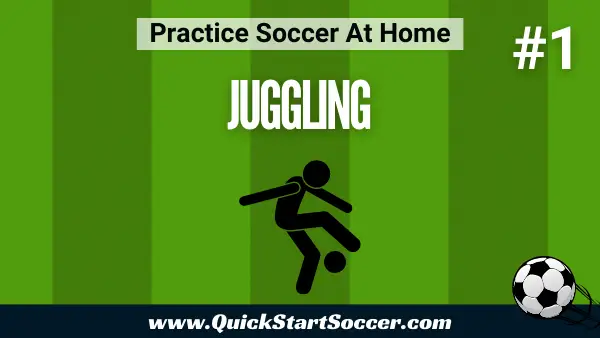
A fantastic way to practice soccer at home and improve your ball control is to practice juggling. All you need for this is a soccer ball and some space, so this exercise can be done at home in your backyard, in the park, or even inside if you have enough space.
There’s a reason that youth soccer coaches often quote the phrase “Not all great jugglers are great players but all great players can juggle” and that’s because juggling helps improve many essential soccer skills. Juggling will help you improve your first touch and make you more comfortable with the ball. It also helps you to learn how to control the ball with different parts of your feet, legs, and chest.
If this is your first time practicing juggling at home, then a great way to start is to simply drop the ball from your hands onto your foot or thigh and then see how many times you can kick the ball up before it touches the ground. The total amount of touches is your ‘best score’ and each time you juggle the ball you can try and beat your personal best.
To start juggling, you can drop the ball from the air onto your foot or thigh and then see how many times you can touch the ball before it hits the ground again. Your total amount of touches you take is your ‘best score!’. Each time you juggle you can try and beat your personal best!
Here are some tips on how to get the most out of practicing juggling at home:
- Keep your ankle locked and the toes of your kicking foot curled up as you kick the ball.
- Strike the ball directly underneath using the instep of your foot.
- After each touch, you should rebalance yourself by placing both feet on the ground.
- To help maintain control of the ball try and keep the ball below chest height at all times (the better you get the lower you can keep the ball).
For players who are young or new to juggling, you can make things easier by allowing a bounce in between each touch or using your thighs to juggle initially. For more advanced players you can start by flicking the ball up in the air (instead of dropping it from your hands) and set yourself various challenges, such as juggling with your weaker foot only, alternating which foot you kick the ball with, or using different parts of your body to keep the ball up in the air in different sequences (e.g, foot, thigh, head, foot, thigh!). The possibilities are endless and all you need to practice is a ball and a bit of space!
Ball And Wall
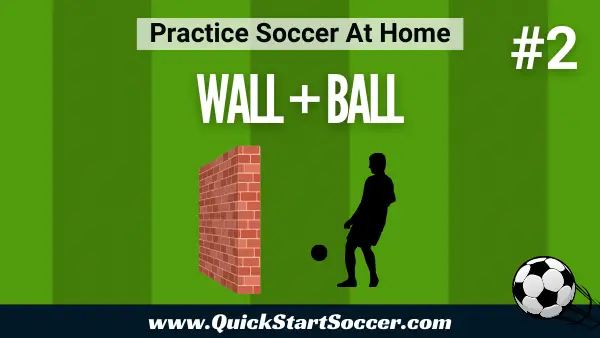
Kicking a ball against a wall may sound boring, but it is anything but! It’s also one of the best ways you can practice soccer at home. Countless professional players hark back to the time they spent as a child kicking a ball against a wall at various speeds, heights, and with different spins on the ball, as they hone their skills. Like juggling, it can become highly addictive once you get into a rhythm and routine.
To start, stand about two meters away from a brick wall, kick the ball against the wall with any part of your foot and get ready for the rebound. When the ball returns, strike it again, and again, and keep going as long as you can. Be sure to keep the ball moving at speed and retain your balance in between each strike.
Like juggling, there are countless variations you can use when kicking a ball against a wall! Here are some of our favorites:
- Use the instep of your foot, first with your stronger foot only, then with your weaker foot only. Then try alternating left and right but only using your instep.
- Take two touches each time you receive the ball. One to steady the ball and one to strike it. Try your best to minimize the amount of time in between each touch and get into a quick rhythm as soon as possible. Alternate which feet you use or try using one foot only.
- Keep the ball in the air as you kick the ball against the wall. Take just one touch at a time or two (i.e one to receive and one to kick the ball back against a wall).
- Use your head to hit the ball against the wall and see how many touches you can have before it drops to the ground.
Dribbling In A Circuit

A fantastic way to improve your coordination, technique, and ball control is by practicing your dribbling skills at home in a homemade circuit. For this practice exercise, all you need are some cones and a ball. If you don’t have cones you can simply use something small to mark out the circuit.
You can set up any kind of circuit but here are ideas to get you started:
- Place a line of 5 cones in a straight line with about two yards in between each cone. Dribble in and out of each cone then turn around and complete the circuit again.
- Place 2 cones 10 yards apart and dribble back and forth in between the cones, being sure to go around each cone as you get there.
- Using 6 – 8 cones, create a zig-zag pattern with each cone 3-4yards apart. Make sure you dribble around each cone as you complete the circuit.
When dribbling with the ball it’s important to take larger touches and longer strides when you’re trying to dribble at speed, and shorter strides with defter touches when you’re trying to change direction or dribble with more control. When turning and going around cones it’s also important to remember to keep your knees bent and your arms out for balance.
Different Dribbling Moves
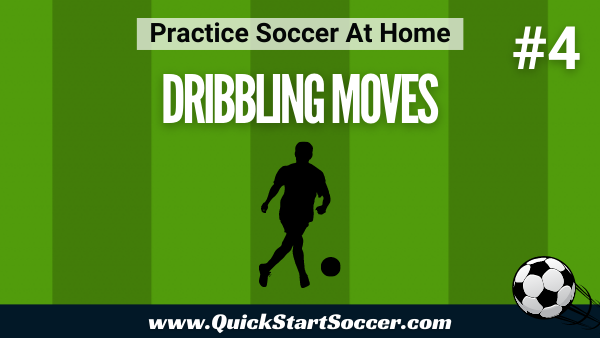
The great thing about dribbling moves is that you can practice them on your own at any time. All you need is a ball and a little space! Having just one or two go-to dribbling moves that you can use effectively in games can be a huge advantage.
Most dribbling moves involve some kind of feint followed by an explosion of pace to escape a defender. When practicing dribbling moves at home on your own, obviously there is no defender to play against and so it’s best to always exaggerate the feint/fake out and accelerate away quickly after completing the move.
Here are four dribbling moves you can practice at home. These are all easy to practice but hard to master.
The Inside Cut
To do an inside cut you should use the inside of your foot (or inside of your big toe) to change the direction of the ball. Start by dribbling the ball forward keeping the ball at your feet. Then use the inside of your kicking foot to cut the ball across your body, changing direction whilst maintaining forward momentum. Try your best to accelerate after the cut as if you are running away from a defender.
The Outside Cut
The outside cut is just like the inside foot but uses the outside of the foot to change direction. Start by dribbling the ball forward, keeping the ball close to your feet, and then bring your kicking foot behind the ball moving it from outside to in. The outside of your foot should now be in a position to cut the ball sharply away from your body whilst once again accelerating away.
The Matthews
For the Matthews move, you essentially pretend to do an inside cut before doing an outside cut. It’s a two-touch move in which you start by dribbling the ball forward and then take a light touch with your big toe (faking to cut inside) before taking a heavier touch with your little toe and accelerating away in the opposite direction.
The Scissors
For beginner players, the scissors can be complicated initially so it’s probably best to start practicing from a standing position before doing it on the move. A good way to remember the concept of the scissors is that you’re essentially pretending to do an outside cut with one foot before doing an outside cut in the opposite direction with the other.
To practice the scissors, first stand behind the ball with your legs shoulder-width apart. Bring one foot forward as if you are going to push the ball with the outside of your foot but instead step over the ball without touching it. Plant that foot on the ground and then use your other foot to cut the ball in the opposite direction. Once you get the hang of things try doing the move whilst dribbling forward with the ball, remembering to accelerate away after completion of the move
Soccer Tennis
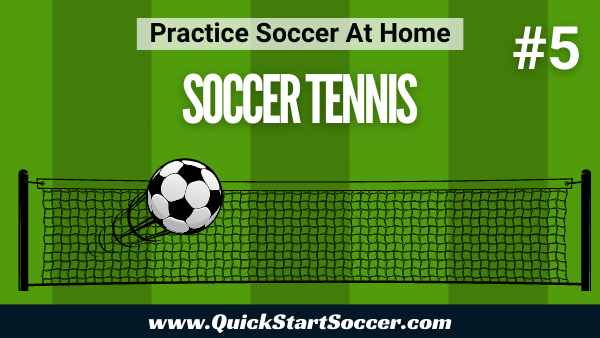
Soccer tennis is a fantastic game you can play to practice your soccer skills at home. For this game, you will need a partner, so this is a great soccer game to play with friends. If you’re not familiar with soccer tennis, it’s an incredibly fun game that works on volleying, heading, and kicking skills as well as receiving the ball in the air. It’s best played on a regular tennis court but if you’re not close to the one you can use anything (such as flat cones, tall cones, or markers) to create the court and net.
To begin, one player ‘serves’ the soccer ball over the ‘net’ by kicking it in the air out of their own hands. The opposite player has to return it by kicking it back after only one or two bounces (depending on ability) on their side. Play goes back and forth until one player fails to return it or the ball is kicked out of bounds. The non-offending player gets a point and takes the next serve in the game.
Figure Of 8 Drill
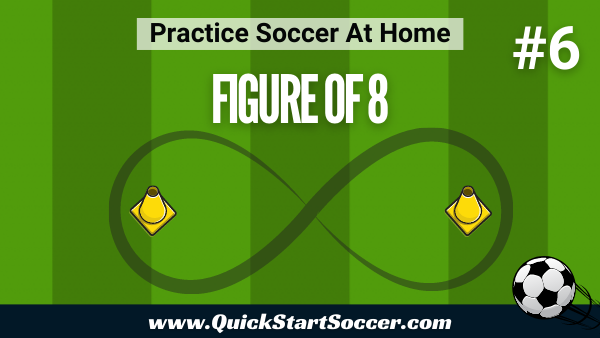
This simple practice drill you can do at home is great for practicing different turns while maintaining control of the ball. For this drill, you need two cones and a soccer ball. Set up the cones in your backyard approximately 5 yards apart.
To begin, stand behind one of the cones and dribble towards the other cone and then around the outside of that cone. As you take the ball around the cone, use turns such as the inside cut and outside cut, and then dribble back towards the other cone and go around the outside of that cone. Continue like this so you are making a figure of 8 and try an switch up your turns eat time.
Watch And Learn
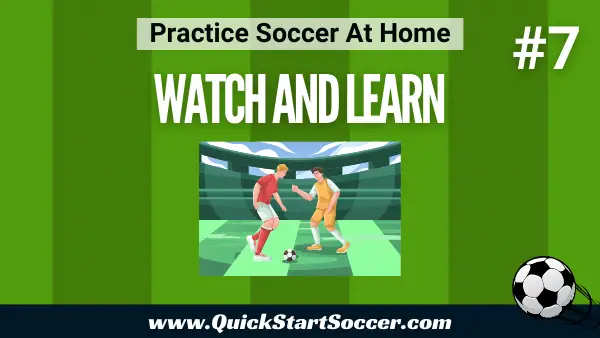
Although this is not ‘practicing soccer’ per se, it is just as important to improve your soccer skills at home. Watching soccer is an incredibly important part of any young player’s development and as such watching games regularly needs to be part of every player’s practice routine.
Whilst watching any level of soccer is good, the English Premier League is undoubtedly the most exciting and televised league in the world, so we’d advise starting there. Whether you pick and follow a specific team or just watch whatever game fits best into your schedule it’s incredibly useful to see how the best of the best play and compete. Also, you might see a move or technique you have never seen before and so this can be another thing you practice at home.
Related
Thanks for reading. I hope you have lots of fun practicing soccer at home with these drills. Before you go, here are some related posts you might be interest in: Soccer Games To Play With Friends /
Soccer Warm Up Games For Kids

